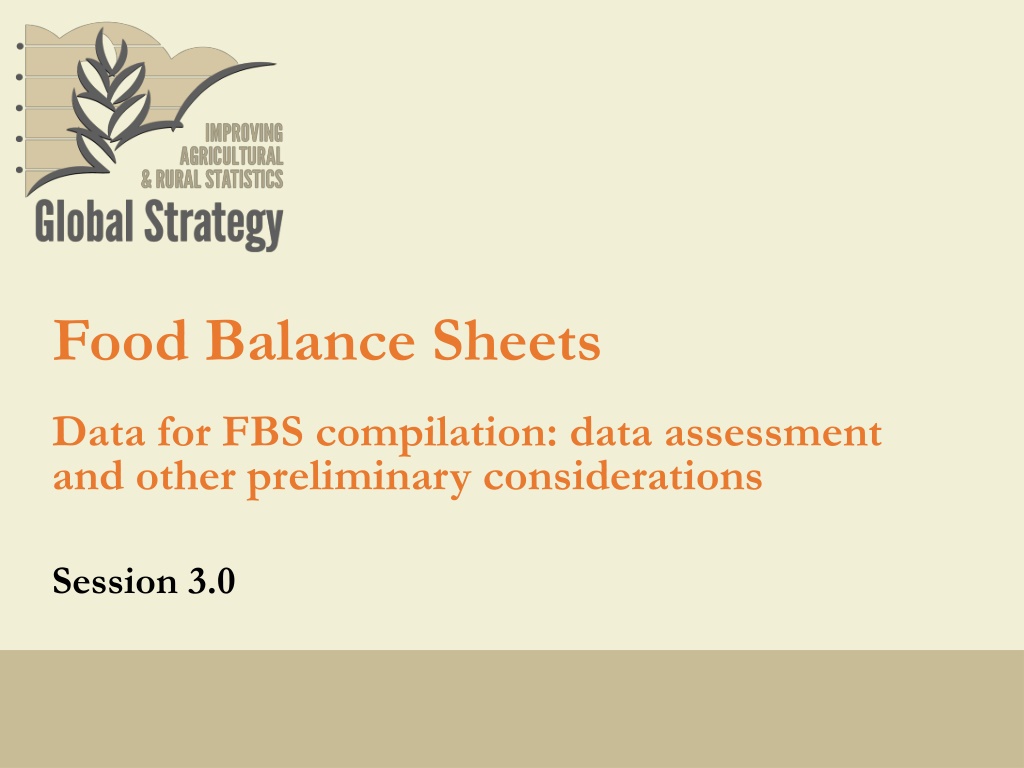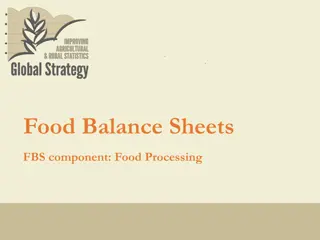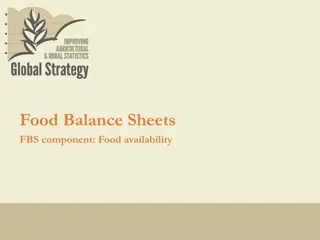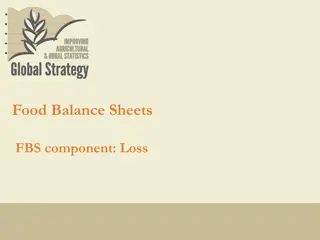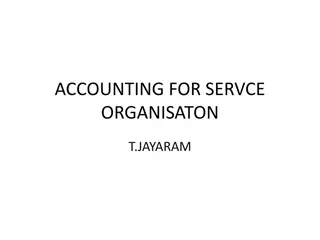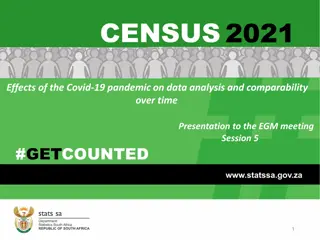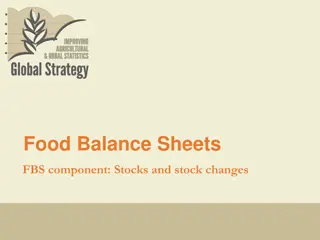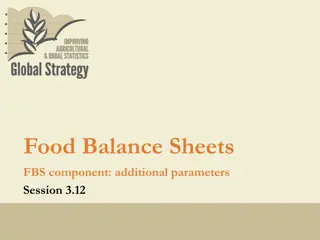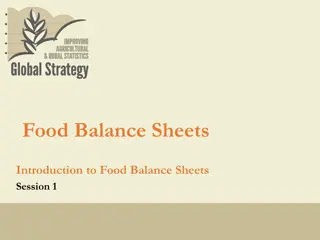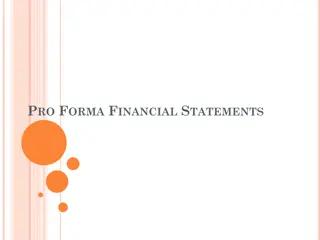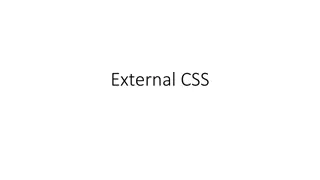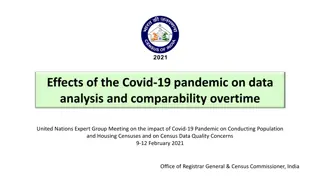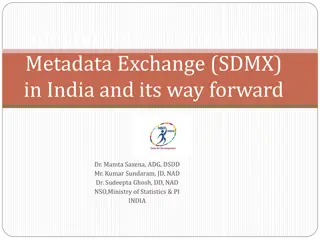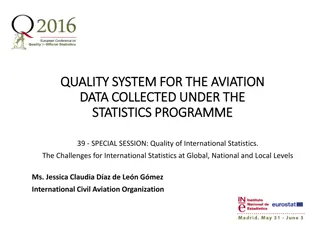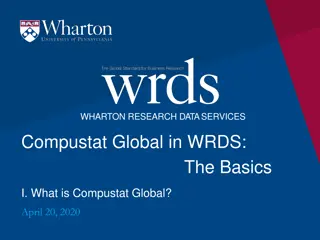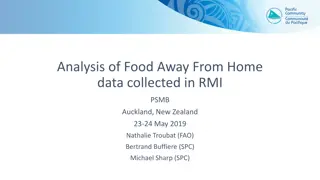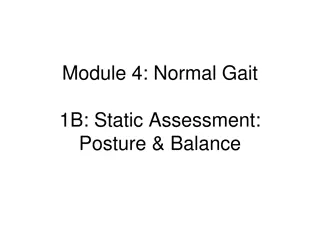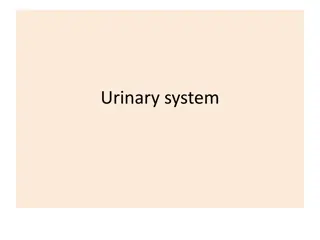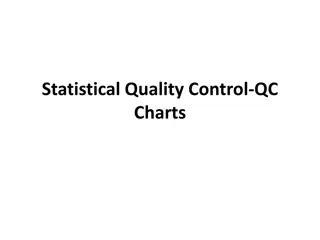Understanding Data Comparability and Quality in Food Balance Sheets
Data assessment is crucial for compiling Food Balance Sheets (FBS) to ensure comparability. The session covers dealing with different data sources, prioritizing them, rules for data comparability, and establishing a system for data search and assessment. Key points include preparing an inventory of data sources, assessing data quality, and documenting data used. Learn about the importance of fully comparable data, statistical classification, and avoiding errors to ensure accurate comparisons in FBS.
Download Presentation

Please find below an Image/Link to download the presentation.
The content on the website is provided AS IS for your information and personal use only. It may not be sold, licensed, or shared on other websites without obtaining consent from the author. Download presentation by click this link. If you encounter any issues during the download, it is possible that the publisher has removed the file from their server.
E N D
Presentation Transcript
Food Balance Sheets Data for FBS compilation: data assessment and other preliminary considerations Session 3.0
Learning Objectives At the end of this session, the participants will: a) Know how to deal with different data sources and how to prioritize them b) Know the different rules and guidelines to ensure data comparability c) Be able to put in place a system for data search and assessement 2
Outline 1. Data comparability 2. Data quality, measurement error and flags 3. Data search and assessment 3
Introduction Data assessment is the crucial first step in the FBS compilation, as it help compilers to ensure data comparability What to do Prepare an inventory of potential data sources (for all the relevant variables for each commodity) Assess the quality of the data Document all the data sources used 4
I. Data comparability: Introduction Data need to be fully comparable. a) Item b) Comparability Includes: Referenc e period c) Unit of measure ment 6
I. Data comparability: a) The use of statistical classification Why to ensure that the products being compared are actually the same? Example: production for rice: Production is recorded on a paddy basis Tourist food is recorded on a milled basis unintentional error introduced in to the balancing process 7
I. Data comparability: a) The use of statistical classification How to avoid these kinds of errors? Using international statistical classification comparability of products within a balance sheet framework comparability of data between countries 8
I. Data comparability: a) The use of statistical classification UN Central Product Classification (CPC), Version 2.1 is maintained by the UN Statistics Division (UNSD) organizes products into a five-level hierarchical structure is mapped to the HS classification for international trade FAO developed the CPC ver.2.1 expanded for agriculture, an annex on agricultural statistics expanded adding two more digits at the lower level 9
I. Data comparability: a) The use of statistical classification UN Central Product Classification (CPC) SECTION DOMAIN 0 Agriculture, forestry and fishery products 1 Ores and minerals; electricity, gas, water Food products, beverages and tobacco; textiles, apparel and leather products Other transportable goods, except metal products, machinery and equipment 4 Metal products, machinery and equipment 5 Construction and construction services Distributive trade services; accommodation, food and beverage serving services; transport services; and electricity, gas and water distribution service Financial and related services; real estate services; and rental and leasing services 8 Business and production services 9 Community, social and personal services 01 Products of agriculture, horticulture and market gardening 02 Live animals and animal products (excluding meat) 03 Forestry and logging products 04 Fish and other fishing products 2 3 21 Meat, fish, fruit, vegetables, oils and fats 22 Dairy products and egg products Grain mill products, starches and starch products; other food products 24 Beverages 25 Tobacco products 26 Yarn and thread; woven and tufted textile fabrics 27 Textile articles other than apparel 28 Knitted or crocheted fabrics; wearing apparel 29 Leather and leather products; footwear 23 6 7 10
I. Data comparability: a) The use of statistical classification Although data in the SUA/FBS are reported in CPC, data on trade are usually reported in HS. Harmonized Commodity Description and Coding System (HS) Classification developed by the World Customs Organization Most widely utilized classification in the context of international trade o used by more than 200 countries and covers 98 percent of international merchandise trade Hierarchical structure o Organized in 97 chapters, includes 5,000 six-digit product groups 11
I. Data comparability: a) The use of statistical classification The use of the HS for trade data within the FBS context is recommended: data comparability purposes ease of concordance with the CPC 12
I. Data comparability: a) The use of statistical classification Harmonized Commodity Description and Coding System (HS) SECTION Live animals; animal products Vegetable products Animal or vegetable fats and oils and their cleavage products; prepared edible fats; animal or vegetable waxes Prepared foodstuffs; beverages, spirits and vinegar; tobacco and manufactured tobacco substitutes Mineral products VII Products of the chemical or allied industries Plastics and articles thereof; rubber and articles thereof Raw hides and skins, leather, furskins and articles thereof; saddlery and harness; travel goods, handbags and similar containers; articles of animal gut (other than silk-worm gut) X Wood and articles of wood I II CHAPTER III 1 2 Live animals Meat and edible meat offal Fish and crustaceans, molluscs and other aquatic invertebrates Dairy produce; birds' eggs; natural honey; edible products of animal origin, not elsewhere specified or included. Products of animal origin, not elsewhere specified or included IV 3 VI 4 VIII 5 IX 13
I. Data comparability: a) The use of statistical classification Some supporting material: Guidelines on International Classifications for Agricultural Statistics http://gsars.org/en/guidelines-on-international-classifications-for-agricultural-statistics/ CPC Version 2.1 http://unstats.un.org/unsd/cr/downloads/CPCv2.1_complete%28PDF%29_English.pdf Correspondence table FCL/CPC/HS http://www.fao.org/economic/ess/ess-standards/commodity/en/FAOSTAT Definition and classification of commodities http://www.fao.org/waicent/faoinfo/economic/faodef/faodefe.htm 14
I. Data comparability: b) Common units Ensure that product values are reported in common units e.g. agricultural products can be reported in MT, in 1,000 MT, in quintales, etc. e.g. most trade data is reported in MT e.g. most calories conversion tables are in cal. Per kilograms Need to unify these units It is recommended that countries elaborate balance sheets in MT 15
I. Data comparability: c) Reference period Two common reference periods are: 1. marketing year (or crop year, or agricultural year) begins in the month when the bulk of the crop in question is harvested 2. calendar year begins in the first month of the calendar (Jan./Dec.) 3. fiscal year Time defined by governments for accounting purposes Difficult to understand conceptually Comparison not easy because fiscal year from country to country It is recommended that countries compile their FBS on a calendar year basis 16
I. Data comparability: c) Reference period MARKETING YEAR CALENDAR YEAR Advantages It closely follows the cycle of each season (i) provide neutral reference period (ii) is the default reporting periods for trade data Limitations (i) for crops harvested at different points in the year (ii) for countries that experience multiple harvest (iii) trade data is often by default aggregated into calendar years It can be difficult to understand conceptually production should be assigned to the calendar year in which most of the crop will be consumed 17
II. Data quality, measurement error and flags 18
I.4. Data quality, measurement errors and flags When compiling FBS, data are extracted from a variety of different sources Different degrees of quality e.g. official sources are usually more transparent, and the methodology on data collection is available e.g. non-official sources may be less transparent 19
I.4. Data quality, measurement errors and flags: Hierarchy of data sources Official data are always preferred for expected values if multiple agencies publish data relating to agricultural output (e.g. NSI and Min. of Agriculture) Reconciliation of estimates between different official sources is recommended Semi-official data include: industry groups, trade publications, specialized sectorial publications, investigations conducted by product value chain experts, etc. are used when official data are not available 20
I.4. Data quality, measurement errors and flags: Hierarchy of data sources Imputation of missing data are used when no official or semi-official sources can be found relies on a historical data series separate imputation approaches are recommended for different variables in the balance sheet Estimation is the lowest quality level of source data is different from imputation: it relies not on a model, but instead on expert judgment 21
II.1. Data quality, measurement errors and flags: Flags to denote data source As data are taken from different sources, with different quality, it is recommended to publish a flag denoting the data source Flags help users to: Understand which data are more reliable than others Assign measurement errors to be used in the balancing process Example of flags denoting data source Source Official Semi-official Imputed Estimated Flag * I E 22
II.2. Data quality, measurement errors and flags: Implied measurement error For the balancing phase it is necessary to assign an a priori implied measurement error it denotes the perceived quality of the data The highest quality data can be assumed to have an higher confidence. How to assign an implied measurement error? Two possible approaches: a) based on data sources b) based on variable 23
II.2. Data quality, measurement errors and flags: Implied measurement error a) Assign an implied measurement error based on data sources in this approach, the data quality flags are used o example: (not prespective) Measurement error 0% Confidence Source Flag 1.0 Official 0.9 10% Semi-official * 0.85 15% Imputed I 0.6 40% Estimated E Compilers should examine the local statistical systems and data sources to see if the use of these flags and confidence levels are appropriate to their situation 24
II.2. Data quality, measurement errors and flags: Implied measurement error b) Implied measurement error based on variable This approach is more practical when the data in individual SUA s for a given commodity tree come from sources for the same element. o example: Food from wheat flour is measured ( official flag), but food from bulgur of wheat is estimated at the FBS level (in the example wheat & prod.) there would not be a single flag 25
II.2. Data quality, measurement errors and flags: Implied measurement error b) Implied measurement error based on variable ( cont.) Production Usually measured through agricultural surveys there should be high confidence in the production estimate Trade Most countries should have official data on imports and exports high confidence o In case where sizeable quantity are not registered in official trade data, compilers may assign some degree of measurement error 26
II.2. Data quality, measurement errors and flags: Implied measurement error b) Implied measurement error based on variable ( cont.) Stocks By their very nature they may fluctuate wildly from year to year Most estimates on stocks are based on expert judgement (few countries measure stock) the confidence is likely to be lower than estimates for other variables Food and tourist food Although it is not typically measured by countries, food consumption is not likely to fluctuate greatly the confidence in the food estimate should be quite high 27
II.2. Data quality, measurement errors and flags: Implied measurement error b) Implied measurement error based on variable ( cont.) Food processing In most cases this variable is dropped from the FBS (in order to avoid double- counting) not need to assign a measurement error Food and tourist food Measurement error depends upon how the feed estimate is derived it may be quite high Seed Quantities of seed needed for the following year are solely a function of planted area and seeding rates (remain stable) measurement error should be fairly low 28
II.2. Data quality, measurement errors and flags: Implied measurement error b) Implied measurement error based on variable ( cont.) Industrial Use Usually only limited data is available the measurement error will be fairly low Loss data on loss is very limited the quantity lost may vary greatly from year to year (due to crop size, constraints in storage, weather, etc.) the measurement error is likely to be high. 29
II.2. Data quality, measurement errors and flags: Implied measurement error Example: Confidence levels given a priori knowledge of variables (not prescriptive) Implied measurement error 0% 0% 50% 20% 0% 40% 10% 20% 50% 50% Variable Confidence Production Trade Stocks Food Food processing Feed Seed Tourist Consumption Industrial Use Loss 1.0 1.0 0.5 0.8 1.0 0.6 0.9 0.8 0.5 0.5 Values in this table should be based on a discussion of the quality of data inside the country compiling the FBS. 30
Data search and assessment 1ststeps in compiling FBS: 1. Search all possible available data sources 2. Assess each data sources for both data comparability and data quality o Note the frequency with which the data is produced, the classification system used, the unit, reference period and the data quality or flag 3. Document all these information in order to transparency and institutional memory 32
III. Data search and assessment Sample data assessment grid Release date/ frequency Reference Period Variables Sources Classification Unit Quality/Flag Production Trade Stocks Food Etc. 33
Conclusion It is really important to ensure the comparability when compiling a FBS The SUA/FBS is in CPC. Use the HS for trade data (then converted is CPC) It is recommended that countries elaborate FBS in MT The calendar year is recommended for the reference period For data quality, the preferred hierarchy of data sources is: official data, semi-official data, data imputation and data estimation It is important to give flags to the data Measurement error based on variables is helpful during the balancing phase 34
References Global Strategy to improve agricultural and rural statistics, 2017. Hanbook of Food Balance Sheet, pp 45-58., Rome, Italy 35
